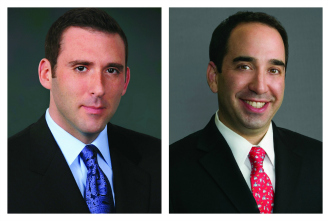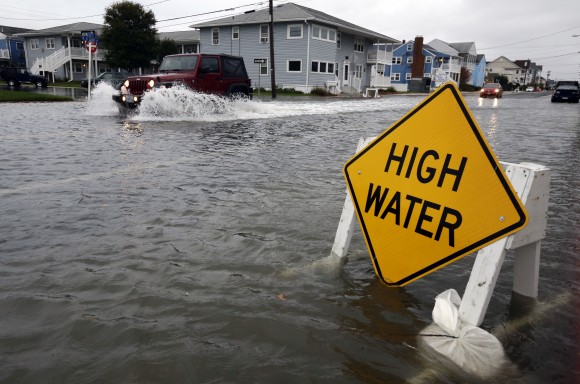Homeowners, businesses, and municipalities in the tri-state area continue to rebuild and rebound from Superstorm Sandy.
Often, large-scale devastation and destruction are followed by lawsuits against individuals and entities allegedly responsible for protecting, managing, and maintaining the damaged buildings. A handful of such lawsuits have been recently filed in New York City on behalf of residents of large residential buildings.
If these suits are predictive of future legal actions, individuals and entities charged with protecting and managing damaged buildings can anticipate lawsuits claiming monetary damages caused by inadequate preventative measures before Sandy, and insufficient recovery measures thereafter.
Additional allegations pled in these initial suits include negligence, permitting unlawful entry into residential buildings, and failing to mitigate damages.
These recent lawsuits and expected future lawsuits are reminders of the significant alleged liabilities that building owners, real estate development and management companies, and volunteer condominium and cooperative board members face in Sandy’s aftermath.
Even if Sandy-related lawsuits are ultimately unmeritorious, potential defendants likely will incur significant legal fees disproving their liability.
For those businesses facing potential liability from negligence and breached duties claims, liability insurance may be an important asset to help offset defense costs and settlement or judgment payments.
CGL Coverage for Defense and Indemnification of Businesses and Municipalities
Businesses and boards facing even completely groundless allegations made in suits seeking damages for acts or inaction leading up to and after Sandy should look for protection to their liability insurance policies.
Businesses frequently purchase Comprehensive General Liability (“CGL”) policies, which often are referred to as “litigation insurance.” CGL policies cover businesses for the costs incurred defending and reasonably resolving suits seeking to hold them liable for alleged bodily injuries or property damage.
The insurer’s “duty to defend” policyholders under CGL policies is a valuable aspect of the coverage. A CGL policy’s insuring agreement typically provides that the insurer “will have the right and duty to defend any ‘suit’ seeking damages [covered by the indemnity provisions of the policy].”
A court determines the duty to defend by comparing the allegations of the underlying complaint with the terms of the policy; a duty to defend arises if the underlying complaint alleges facts within, or potentially within, policy coverage.
The duty extends to groundless, false, or fraudulent allegations in the underlying action, provided those allegations, if later proven true, would fall within coverage.
For the purposes of a duty to defend analysis, any doubt about the underlying allegations being covered is resolved in favor of the policyholder. Consistent with this principle, in most jurisdictions, the insurer has a duty to defend the entire underlying action provided that any allegation in the underlying action falls within coverage.
Insurers often argue that the damages sought in the underlying action are for non-covered economic loss as opposed to the requisite “bodily injury” or “property damage.” However, no exclusion exists in CGL policies for economic loss.
The only question is whether the damages sought are “because of” bodily injury or property damage. Whether damages are “because of” bodily injury or property damage is a question of causation, traditionally a question of fact, which should be resolved by the jury or the finder of fact at trial.
Moreover, courts have held that economic losses that flow from bodily injury or property damage can be covered under a standard form CGL policy. Accordingly, businesses with CGL coverage should demand and expect, at the very least, to be afforded a full and complete defense of lawsuits alleging a negligent failure to prudently act in preparation for and/or following Sandy.
Whether an insurer has a duty to indemnify its policyholder depends on whether the policyholder is legally obligated to pay damages because of bodily injury or property damage to which the insurance applies.
A coverage action should not require the policyholder to conclusively establish its own liability in the interests of promoting settlement. Rather, the proper inquiry is whether the claims were not even potentially covered by the insurance policy.
Thus, when a policyholder settles a potential liability in anticipation of covered claims, the burden is often placed on the insured to prove coverage of the settlement in the first place but then on the insurer to prove the existence of exclusions barring coverage.
Accordingly, coverage should exist so long as a policyholder settles in reasonable anticipation of insured exposures and the insurer cannot show a readily apparent or objectively reasonable basis for attributing any portion of the settlement to uncovered claims.
Disputes often arise under CGL policy language that bars coverage for injury or damage that is expected or intended from the policyholder’s standpoint.
Insurers frequently attempt to argue that this language excludes any harm that was reasonably foreseeable to the policyholder—a standard that, if applied literally, would eviscerate almost all coverage because most of the tort liability theories under which a policyholder could be held liable require a showing that the harm was reasonably foreseeable.
Most jurisdictions instead apply a subjective test that bars coverage only if the policyholder actually intended the harm or knew that it was substantially certain to take place.
D&O Coverage for Defense and Indemnification of Condominium and Cooperative Board Members
Management companies, board members, and officers or directors allegedly responsible for disaster preparation or building security may be named as individual defendants in Sandy-related liability suits.
The individuals and the corporate entities responsible for indemnifying these individuals may call on their Directors and Officers (“D&O”) policy for coverage. D&O policies are often purchased to protect an entity’s directors and officers, as well as the entity itself in some situations, from alleged wrongful conduct.
D&O policies typically contain several coverage grants. Under Side A coverage, the insurer agrees to indemnify the individual directors and officers for all “Loss” that those individuals become legally obligated to pay arising out of a “Wrongful Act” committed in their capacity as a director or officer.
Side A coverage only responds, however, where the policy provides insurance to pay the directors’ and officers’ personal liabilities for which the corporation either cannot or will not provide indemnification.
Side B coverage reimburses the corporation for all payments for which the company is required to indemnify, or has legally indemnified, the directors or officers for “Loss” resulting from a claim alleging a Wrongful Act. The scope of coverage a D&O policy affords may be dependent on the definition of, and case law of the applicable jurisdiction construing, the terms “Loss,” “Claim,” “Wrongful Act,” and “Capacity.”
D&O insurance generally does not impose a duty to defend on the insurer. Rather, D&O insurers generally have a duty to pay defense costs incurred in defending claims. This feature of D&O coverage provides policyholders with substantial control over the defense of claims and generally allows them to choose their own defense counsel and handle their own settlement negotiations.
However, even though policyholders and their defense counsel may be able to control many aspects of the defense, D&O policies typically mandate that policyholders obtain the insurers’ consent before incurring any defense costs or settling any claims.
As with the duty to defend under a CGL policy, the D&O insurer’s duty to pay defense costs generally should extend to all claims that are potentially covered under the policy.
E&O Coverage for Defense and Indemnification of Management Companies and Condominium and Cooperative Boards
Building tenants may allege that management companies’ and condominium/cooperative boards’ acts, errors, or omissions leading up to and after Sandy constituted a failure to provide professional services such as disaster preparation or building security.
These entities may call on their Errors & Omissions (“E&O”) policy for coverage. E&O policies are often purchased to insure against liability arising out of an act, error, or omission of the named insured in rendering or failing to render services.
Professional Liability Insurance is a form of E&O insurance designed to protect the professional activities of those who possess specialized knowledge and skills through special education and experience in a particular field.
The professionals that typically fall within this category are accountants, architects, attorneys, engineers, physicians, and veterinarians. This type of insurance often is referred to as malpractice insurance.
E&O policies, however, are not limited to those specialized professions. They can apply to “nonprofessionals” who require coverage for their wrongful acts that cause harm to others. Building managers and board members are examples of individuals in less-specialized fields who may purchase E&O insurance.
E&O insurers frequently agree to pay on the insured’s behalf: “Damages and Claims Expenses which the Insured Shall become legally obligated to pay because of any Claim or Claims first made against the Insured . . . and reported to the Underwriters during the Period of Insurance or Extended Reporting Period arising out of any act, error or omission of the Insured in rendering or failing to render Professional Services.” E&O coverage is sold on a claims-made basis.
The claim must be made against the insured and reported to the insurance company during the policy period. An issue of frequent dispute is whether and when certain allegations or demands constitute a claim. Some policies define what constitutes a claim, but others do not.
It is also critical to check the E&O policy’s Professional Services definition. This definition often will be found in an endorsement tailored to the policyholder’s specific business. The policyholder must be careful to make sure that the definition is sufficient to cover the conduct that could give rise to a claim.
Another issue of frequent dispute is whether the conduct “arises out of” acts of rendering or failing to render Professional Services.
Conclusion
CGL, D&O, and E&O coverages are valuable assets that are available to fund the defense and settlement of Sandy-related lawsuits alleging a failure to promptly and sufficiently act prior to and following the storm. However, a policyholder must act in a timely fashion when seeking coverage under any insurance policy.
Doing so prevents an insurer from denying the claim as untimely. Individuals and entities facing these potential liabilities as a result of Sandy should consult with experienced policyholder counsel, who can help navigate the coverage issues discussed above, as well as others, and then determine if insurance assets can help defray the losses.

Jared Zola is a New York-based partner and deputy practice leader in law firm Dickstein Shapiro LLP’s insurance coverage practice. Zola is also the national co-leader of the firm’s environmental and production liabilities insurance initiative. His practice focuses on representing corporate policyholders in insurance coverage litigation, as well as negotiating settlements with prominent property/casualty insurers.
Jeffrey L. Schulman is a New York-based partner in law firm Dickstein Shapiro LLP’s insurance coverage practice. Schulman is also the national co-leader of the firm’s transactional and private equity insurance initiative and the construction defect insurance initiative. His practice focuses on representing policyholders in disputes with their insurers.
Was this article valuable?
Here are more articles you may enjoy.



 Alliant Latest to Sue Howden US Over Alleged ‘Smash-and-Grab’ Poaching
Alliant Latest to Sue Howden US Over Alleged ‘Smash-and-Grab’ Poaching  Nearly Half of 100 Largest P/C Insurers Destroy Value: ACORD
Nearly Half of 100 Largest P/C Insurers Destroy Value: ACORD  Georgia Republicans Move to Scrap State Income Tax by 2032 Despite Concerns
Georgia Republicans Move to Scrap State Income Tax by 2032 Despite Concerns  Good Times for US P/C Insurers May Not Last; Auto Challenges Ahead
Good Times for US P/C Insurers May Not Last; Auto Challenges Ahead 

